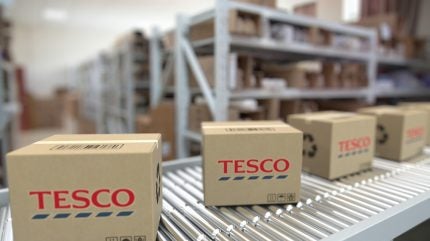
Tesco has outlined its ambition for all own-brand packaging to be fully recyclable by December 2025, alongside a pledge that all paper and board used will be sourced from sustainable materials.
The supermarket’s plan forms part of its broader “4Rs” packaging strategy — remove, reduce, reuse, recycle — aimed at transforming its packaging footprint.

Discover B2B Marketing That Performs
Combine business intelligence and editorial excellence to reach engaged professionals across 36 leading media platforms.
Remove, reduce, reuse and recycle: Tesco’s 4rs strategy
Tesco’s “4Rs strategy” has been in place since 2019 and lays the foundation for its 2025 targets.
As of the latest Sustainability Report, more than 2.5 billion pieces of plastic have been removed from its own-brand products since 2019, which includes elimination of packaging such as lids, film, punnets and bags.
In November 2024, Tesco’s Finest dried pasta range shifted to paper packaging, accomplishing the removal of over 10 million plastic pieces annually.
Further efforts under “reduce” include trimming plastic from cheese packaging, juice cartons, frozen food bags and multipack wrappings, saving hundreds of tonnes of material.

US Tariffs are shifting - will you react or anticipate?
Don’t let policy changes catch you off guard. Stay proactive with real-time data and expert analysis.
By GlobalDataThe “reuse” pillar sees Tesco exploring reusable systems, exemplified by its pilot with Loop in select stores.
Under “recycle”, Tesco aims for full recyclability of packaging, improving collection infrastructure and pushing for clearer recycling policies.
Progress and recycling initiatives
As of early 2025, around 96 percent of Tesco’s own-brand packaging is already recyclable, although kerbside capabilities can vary regionally.
To address recycling gaps, the company has installed soft-plastic collection points in large UK stores, enabling customers to return items that local councils often won’t recycle.
Over 2,000 tonnes of soft plastics have been collected to date, some of which have been repurposed into products like school planters.
Redesigning packaging also supports recycling—Tesco has replaced black plastic packaging with colours like green and brown to improve sorting accuracy in recycling plants.
Industry collaboration and future outlook
Tesco acknowledges that industry-wide change and consistent regulation are essential to meet its 2025 goals. It continues to call for a uniform recycling infrastructure across the UK, such as an effective deposit return scheme and harmonised waste regulations.
Supplier engagement remains key—Tesco requires partners to meet its recyclability standards and to adopt sustainable packaging formats.
In parallel to packaging goals, Tesco aims to halve food waste by end-2025 and redistribute 85 percent of unsold, safe-to-eat food to charities or for animal feed, working with groups like FareShare and Olio.
Tesco targets and consumer impact
Tesco’s commitments reflect growing concern over plastic waste and circular economy challenges. With 70 percent of UK plastic waste from packaging, and millions of tonnes of food thrown away annually, efforts like these play a central role in greener grocery retail.
The emphasis on sustainable packaging, reduced plastic use and better recycling support may help raise consumer awareness and make sustainable shopping simpler and more accessible.





